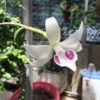# Distinguishing White Egg Orchids from Other Orchid Varieties

## Table of Contents
1. **Introduction**
2. **Overview of Orchids**
– 2.1. General Characteristics of Orchids
– 2.2. The Diversity of Orchid Varieties
3. **Introduction to White Egg Orchids**
– 3.1. Botanical Classification
– 3.2. Unique Features of White Egg Orchids
4. **Comparative Analysis of White Egg Orchids and Other Orchid Varieties**
– 4.1. Appearance and Structure
– 4.2. Growth Conditions and Requirements
– 4.3. Blooming Patterns and Lifespan
– 4.4. Care and Maintenance
5. **Popular Orchid Varieties for Comparison**
– 5.1. Phalaenopsis Orchids
– 5.2. Cattleya Orchids
– 5.3. Dendrobium Orchids
– 5.4. Oncidium Orchids
– 5.5. Vanda Orchids
6. **Cultural Significance and Uses**
– 6.1. Uses of White Egg Orchids
– 6.2. Significance of Other Orchid Varieties
7. **Choosing the Right Orchid for Your Environment**
– 7.1. Factors to Consider
– 7.2. Matching Orchids to Your Space
8. **Conclusion**
9. **FAQs**
—
## 1. Introduction
Orchids are among the most diverse and enchanting plants in the world. With thousands of species and hybrids, they are celebrated for their beauty and complexity. Among these is the White Egg Orchid (*Phalaenopsis amabilis*), known for its pristine white blooms and elegant appearance. This article aims to distinguish White Egg Orchids from other orchid varieties by exploring their unique characteristics, growth conditions, care requirements, and cultural significance.
## 2. Overview of Orchids
### 2.1. General Characteristics of Orchids
Orchids belong to the family Orchidaceae, one of the largest families of flowering plants. They are characterized by their unique flower structures, which often feature three petals and three sepals.
– **Symmetry**: Many orchids exhibit bilateral symmetry, meaning they can be divided into two identical halves.
– **Unique Reproductive Features**: Orchids have specialized reproductive structures called labellum or lip, which can be highly modified to attract pollinators.
### 2.2. The Diversity of Orchid Varieties
Orchids come in an astounding variety of forms, colors, and sizes, with over 25,000 species and more than 100,000 hybrids. This incredible diversity is a result of their adaptability to different environments.
– **Habitat**: Orchids can be found in diverse habitats, from tropical rainforests to temperate regions, each adapting to specific ecological conditions.
– **Cultivation**: Many orchid species are cultivated for their beauty, while others hold significant cultural and economic value.
## 3. Introduction to White Egg Orchids
### 3.1. Botanical Classification
The White Egg Orchid, also known as the Moth Orchid, falls under the genus *Phalaenopsis*. This genus is known for its long-lasting flowers and ease of care, making it a favorite among orchid enthusiasts.
– **Scientific Name**: *Phalaenopsis amabilis*
– **Family**: Orchidaceae
– **Native Range**: Southeast Asia, including the Philippines, Indonesia, and Taiwan.
### 3.2. Unique Features of White Egg Orchids
White Egg Orchids are distinguished by their stunning white blooms, which can reach up to 5 inches across.
– **Flower Structure**: They typically have broad, flat petals and a slightly ruffled lip.
– **Leaf Structure**: The leaves are thick, fleshy, and dark green, providing a stark contrast to the delicate flowers.
## 4. Comparative Analysis of White Egg Orchids and Other Orchid Varieties
### 4.1. Appearance and Structure
While all orchids share some similarities, each variety has distinct features:
– **White Egg Orchids**: Characterized by their smooth, white petals and broad lip. They have a compact growth habit, making them suitable for small spaces.
– **Phalaenopsis Orchids**: Often mistaken for White Egg Orchids, they come in various colors and patterns, including pink, yellow, and purple.
– **Cattleya Orchids**: Known for their large, vibrant flowers and fragrance, they have a more pronounced lip compared to White Egg Orchids.
– **Dendrobium Orchids**: Feature long canes with clusters of small to medium-sized flowers, differing significantly in structure and growth habit from White Egg Orchids.
### 4.2. Growth Conditions and Requirements
Understanding the environmental needs of each orchid type is essential for successful cultivation.
– **White Egg Orchids**: Thrive in warm, humid conditions with indirect sunlight. They require well-draining potting media and regular watering to prevent root rot.
– **Cattleya Orchids**: Prefer bright light and can tolerate slightly cooler temperatures, making them more versatile in different environments.
– **Dendrobium Orchids**: Require a distinct dry period in winter to bloom successfully, which differs from the constant moisture preferred by White Egg Orchids.
### 4.3. Blooming Patterns and Lifespan
Blooming cycles and flower longevity can vary widely among orchid varieties.
– **White Egg Orchids**: Typically bloom multiple times a year, with flowers lasting up to three months.
– **Oncidium Orchids**: Known for their unique sprays of small flowers, they may only bloom once a year but can have multiple spikes per plant.
– **Vanda Orchids**: Famous for their fragrant blooms, they may flower multiple times throughout the year but require specific humidity and light conditions.
### 4.4. Care and Maintenance
Each orchid type has unique care requirements that influence their health and blooming potential.
– **Watering Needs**: White Egg Orchids prefer consistent moisture but must not be waterlogged. In contrast, Cattleya orchids enjoy a dry period between waterings.
– **Fertilization**: All orchids benefit from regular fertilization, but the specific ratios and frequency may differ; for instance, White Egg Orchids thrive with a balanced fertilizer, while Cattleya orchids may require a higher phosphorus formula for blooming.
## 5. Popular Orchid Varieties for Comparison
### 5.1. Phalaenopsis Orchids
Phalaenopsis orchids, commonly referred to as moth orchids, are similar to White Egg Orchids but come in various colors and patterns.
– **Care**: They require similar care conditions, including bright, indirect light and regular watering.
### 5.2. Cattleya Orchids
Cattleya orchids are known for their large, fragrant blooms and vibrant colors.
– **Differences**: They have thicker pseudobulbs and a different growth habit, preferring brighter light and slightly drier conditions.
### 5.3. Dendrobium Orchids
Dendrobium orchids are diverse, with some species requiring dry conditions during the winter.
– **Unique Features**: They typically have tall canes and can produce clusters of flowers.
### 5.4. Oncidium Orchids
Oncidium orchids, often called dancing lady orchids, are known for their charming flowers.
– **Growth Habits**: They prefer bright light and well-draining media, with their flowers blooming in clusters.
### 5.5. Vanda Orchids
Vanda orchids are recognized for their striking, colorful flowers and growth habits.
– **Care Requirements**: They thrive in high humidity and require frequent watering and fertilization.
## 6. Cultural Significance and Uses
### 6.1. Uses of White Egg Orchids
White Egg Orchids are often used in floral arrangements, weddings, and as decorative houseplants. Their elegance symbolizes beauty, love, and refinement.
– **Orchid Shows**: They are frequently featured in orchid exhibitions due to their aesthetic appeal.
### 6.2. Significance of Other Orchid Varieties
Other orchid varieties hold their significance in different cultural contexts.
– **Cattleya Orchids**: Often associated with luxury and are used in high-end floral arrangements.
– **Dendrobium Orchids**: Commonly used in traditional Asian ceremonies, symbolizing respect and admiration.
## 7. Choosing the Right Orchid for Your Environment
### 7.1. Factors to Consider
When selecting an orchid, consider the following factors:
– **Light Conditions**: Ensure that the chosen orchid can thrive in the available light conditions of your space.
– **Humidity Levels**: Some orchids require higher humidity, which may not be suitable for all indoor environments.
### 7.2. Matching Orchids to Your Space
Choosing the right orchid variety for your environment can enhance its growth and your enjoyment:
– **Indoor Spaces**: For low-light areas, consider White Egg or Phalaenopsis orchids, which are more forgiving in lower light.
– **Bright Spaces**: Cattleya or Vanda orchids thrive in bright light, making them ideal for sunny windows.
## 8. Conclusion
Distinguishing White Egg Orchids from other orchid varieties involves understanding their unique features, care requirements, and cultural significance. While White Egg Orchids stand out for their elegant white blooms and ease of care, other orchids offer their own charm and beauty, contributing to the vast diversity of this fascinating family of plants. By understanding these differences, orchid enthusiasts can choose the right variety for their specific environment and preferences, enhancing their gardening experience and enjoyment.
## 9. FAQs
1. **What makes White Egg Orchids unique?**
–
Their pristine white blooms and compact growth make them stand out among other orchids.
2. **How do I care for White Egg Orchids?**
– Provide indirect light, regular watering, and humidity to keep them healthy.
3. **Can White Egg Orchids be grown outside?**
– They thrive indoors, but in suitable climates, they can be grown outdoors in shaded areas.
4. **How often do White Egg Orchids bloom?**
– They can bloom multiple times a year, with flowers lasting several months.
5. **What are the best companion plants for White Egg Orchids?**
– Ferns, peace lilies, and other humidity-loving plants work well as companions.
By understanding the differences between White Egg Orchids and other varieties, you can appreciate the unique beauty of each and make informed choices in your gardening journey. Enjoy exploring the enchanting world of orchids!

